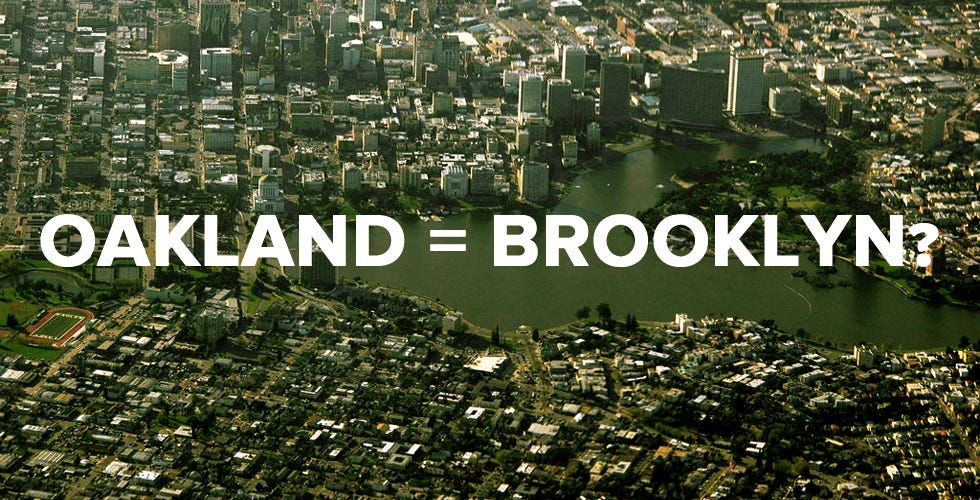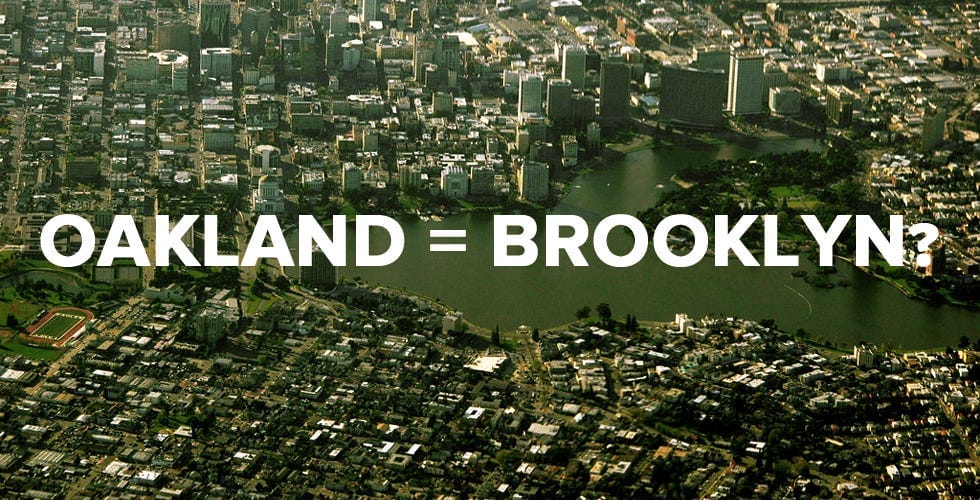
By Peter Lawrence Kane
Smaller, younger, poorer, more diverse, more industrial, less dense, more polluted, less tourist-clogged, cheaper, realer, victimized by snobs, and sitting to the east of “The City.” Is this Oakland vis-à-vis San Francisco, or Brooklyn versus Manhattan? Or could it be both — is Oakland really the Brooklyn of the Golden West?
Mayor Jean Quan herself made the comparison to the National Journal last week, saying, “We’re a little bit like Brooklyn. Because Oakland is so much more affordable than San Francisco, the whole arts scene has shifted over here. The food scene has taken off. Those kinds of cultural things have made Oakland very desirable.” Her words seem like a guarded yet unmistakable shot across the bow at Ed Lee and his mind-bogglingly unaffordable city. Yet both locales are afflicted by and benefiting from the same general trends; San Francisco is just further along. Quan sees an ascendant Oakland sponging up everything quirky and livable about SF as it becomes a playground for the ultra-rich.
But there are lots of ways in which Quan’s comparison of OAK = BKLN falls apart. For one thing, Oakland’s a separate city, not subject to the vicissitudes and policies of a mayor it didn’t vote for, and far enough away that you can’t walk there from the West Bay. At 400,000 people, Oakland’s population is half as big as SF’s and about one-seventh the size of Brooklyn (which is itself twice as populous as Manhattan). Crime in Oakland is considerably higher — the murder rate is more than four times that of New York, and there are six times as many burglaries. And while magically 25 degrees warmer in July than its neighbor, Oakland lacks a certain mystique that, through the alchemy of late capitalism, frequently transmutes into a brand — be it dreaded by long-term residents or lauded by elected officials and other boosters. Without putting Oakland down the way Gertrude Stein’s remark is frequently (mis)interpreted, there are no “Oakland Pickles” or “Oakland Industries” sweatshirts, yet. And much to that city’s credit, at least no celebs are naming their daughter “Oakland.”
At times, it feels as though many Oakland proponents of the analogy are ex-San Franciscans who want to be cooler than San Francisco by being as cool as Brooklyn. (It is universally understood among cool kids that Manhattan is no longer cool). Oakland will be the new Brooklyn for a little while until San Francisco becomes so insidiously homogeneous that every last non-techie decamps for Fruitvale, and then it will presumably supersede San Francisco altogether.
How cool is Oakland? Well, Manhattan is the global capital of all media. Brooklyn has Girls and writers named Jonathan. San Francisco has Looking, the newest Real World, and Blue Jasmine, as well as Twitter, Yelp, Reddit and all the rest. Oakland has Pandora and a growing number of high-profile tech companies, but not nearly as many – and there lays part of its charm, at least for now. Oakland is considered cooler by not being quite as marketable, because Manhattan and San Francisco — and, rapidly, Brooklyn — are taking coolness down with them as they ascend up out of reach. The human body is exquisitely attentive to a certain calculus wherein it feels its movement relative to everything going on around it, not just from geographical center to periphery but in the vertiginous up-is-really-down movement of the city and desire.
Among a “creative class” desperately clinging to what it’s got, there can be an almost Maine-like wariness of outsiders, of contamination, of non-residents pouring in to Instagram once-obscure taquerías on International Blvd. (This dynamic often speaks little of Oakland’s African-American population, which as Mayor Quan noted is still thought to comprise a majority of the city even as it shrank by a quarter from 2000–2010.) But once those tweets and selfies reach critical mass, a TV show will follow, along with even more condos and even worse NIMBYs and all that. It’s happening already, of course, but the progress is slow because Oakland lacks much iconography (although Mike Kimball’s work would be a good nominee). Portland is also the new Brooklyn, Austin is the Hot Portland, Philly is the Sixth Borough and if we’re not careful, we’ll all be living on Staten Island.
But the two cities are tied together by a bridge — actually, two, side by side — a tunnel, Blue Bottle, Burma Superstar, and infinite love. (Even if residents of each city think the others are annoying whiners who never want to cross the bay.) It’s a love that Manhattan and Brooklyn share and that Dallas and Fort Worth can only envy. So maybe it’s better to think of Oakland, San Francisco, Brooklyn, and Manhattan as four teammates, united in their all-consuming disdain for Los Angeles.
Photo by satanslaundromat







